Double Slit Experiment Simulation
By B.E. Alejandro • 6 minutes read •
Double Slit Experiment Simulation Project
🎯 Project Overview
This project presents a comprehensive computational simulation of the famous double-slit experiment, one of the most profound demonstrations in quantum mechanics. The simulation is designed to run on a Raspberry Pi and includes four different visualization modes, each revealing different aspects of wave-particle duality and quantum behavior.
The double-slit experiment, originally performed by Thomas Young in 1801, demonstrates that light and matter exhibit both wave-like and particle-like properties. This project brings this fundamental quantum phenomenon to life through interactive Python simulations.
🔬 The Four Simulations
1. Basic Simulation - Static Interference Pattern
The basic simulation displays the classic interference pattern produced when coherent waves pass through two slits. This visualization shows the fundamental wave behavior with bright fringes (constructive interference) and dark fringes (destructive interference).
Key Features:
- Static interference pattern visualization
- Heat map showing intensity distribution
- Marked slit positions
- Clear demonstration of wave superposition
Visual Result:
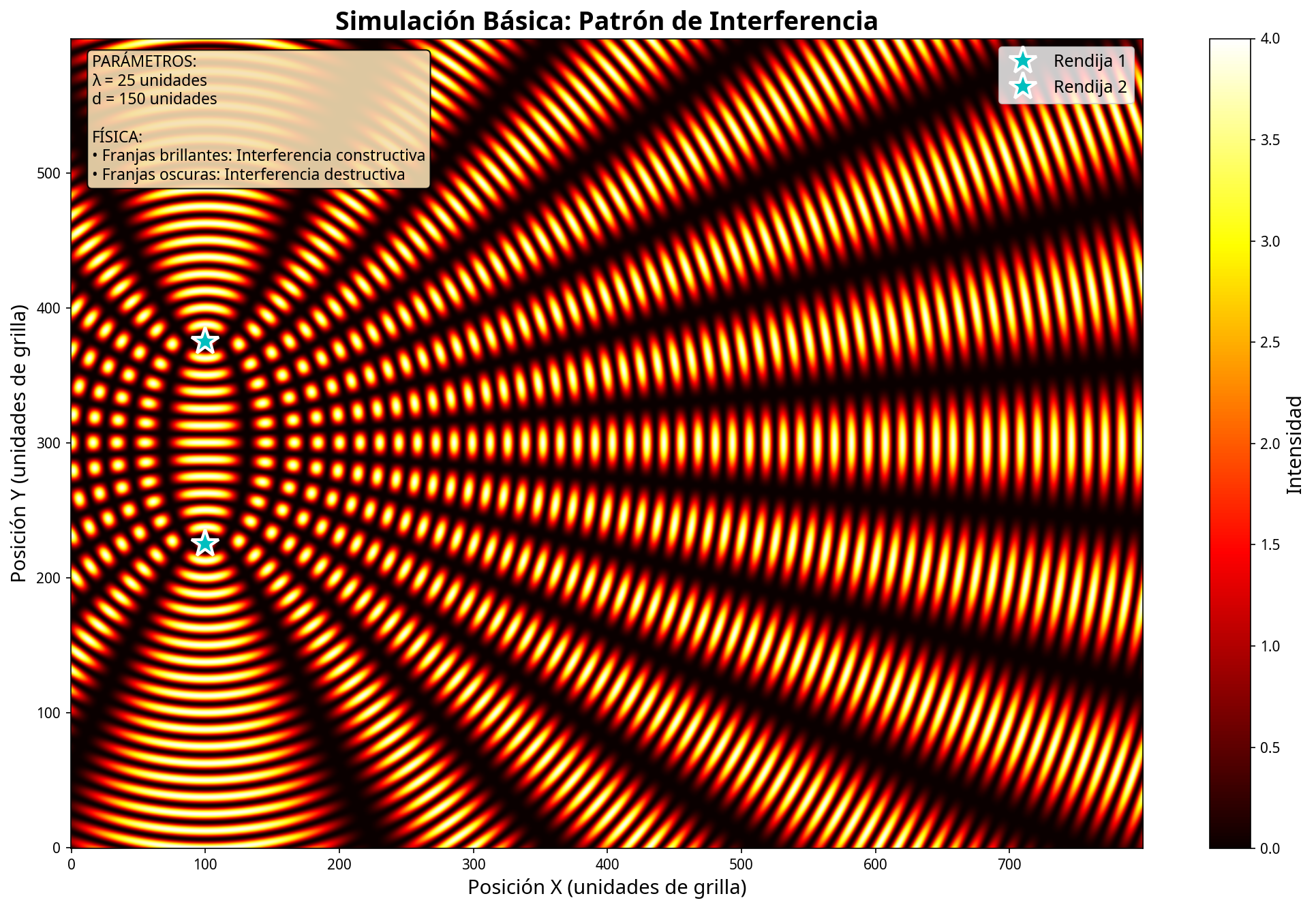
The image shows multiple bright and dark bands, demonstrating how waves from both slits interfere with each other. The cyan stars mark the positions of the two slits.
2. Animated Simulation - Waves in Motion ⭐
This is the most visually striking simulation, showing waves propagating in real-time from both slits. The animation provides an intuitive understanding of how interference patterns form dynamically.
Key Features:
- Real-time wave propagation animation
- Two-panel display: wave amplitude and intensity
- Color-coded visualization (red = wave crests, blue = wave troughs)
- Continuous animation showing wave evolution
Visual Result:
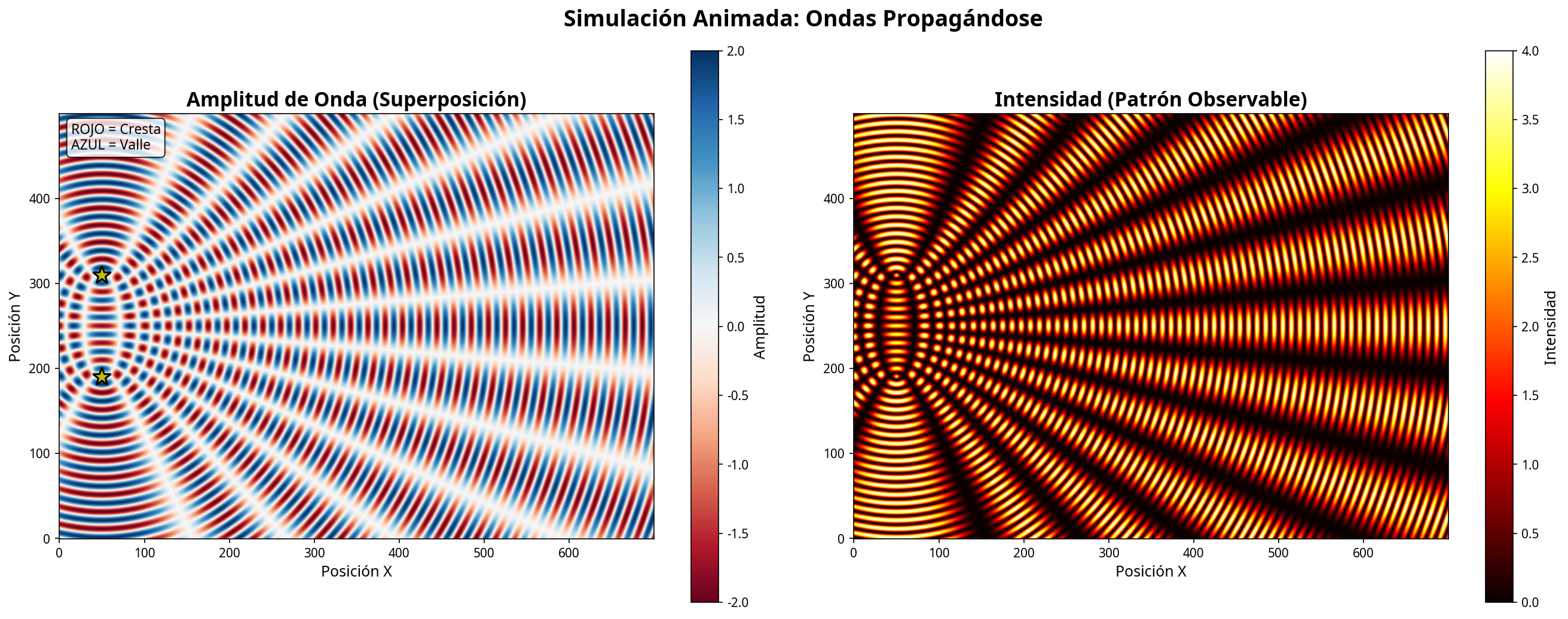
The left panel shows the wave amplitude with red and blue colors representing crests and valleys. The right panel displays the observable intensity pattern that would be detected on a screen.
3. Interactive Simulation - Parameter Exploration
The interactive simulation allows real-time adjustment of experimental parameters, providing hands-on exploration of how wavelength and slit separation affect the interference pattern.
Key Features:
- Adjustable wavelength (λ) slider
- Adjustable slit separation (d) slider
- Toggle between 1 and 2 slits
- Real-time intensity profile graph
- Display of Young’s formula: Δy = λL/d
Visual Result:
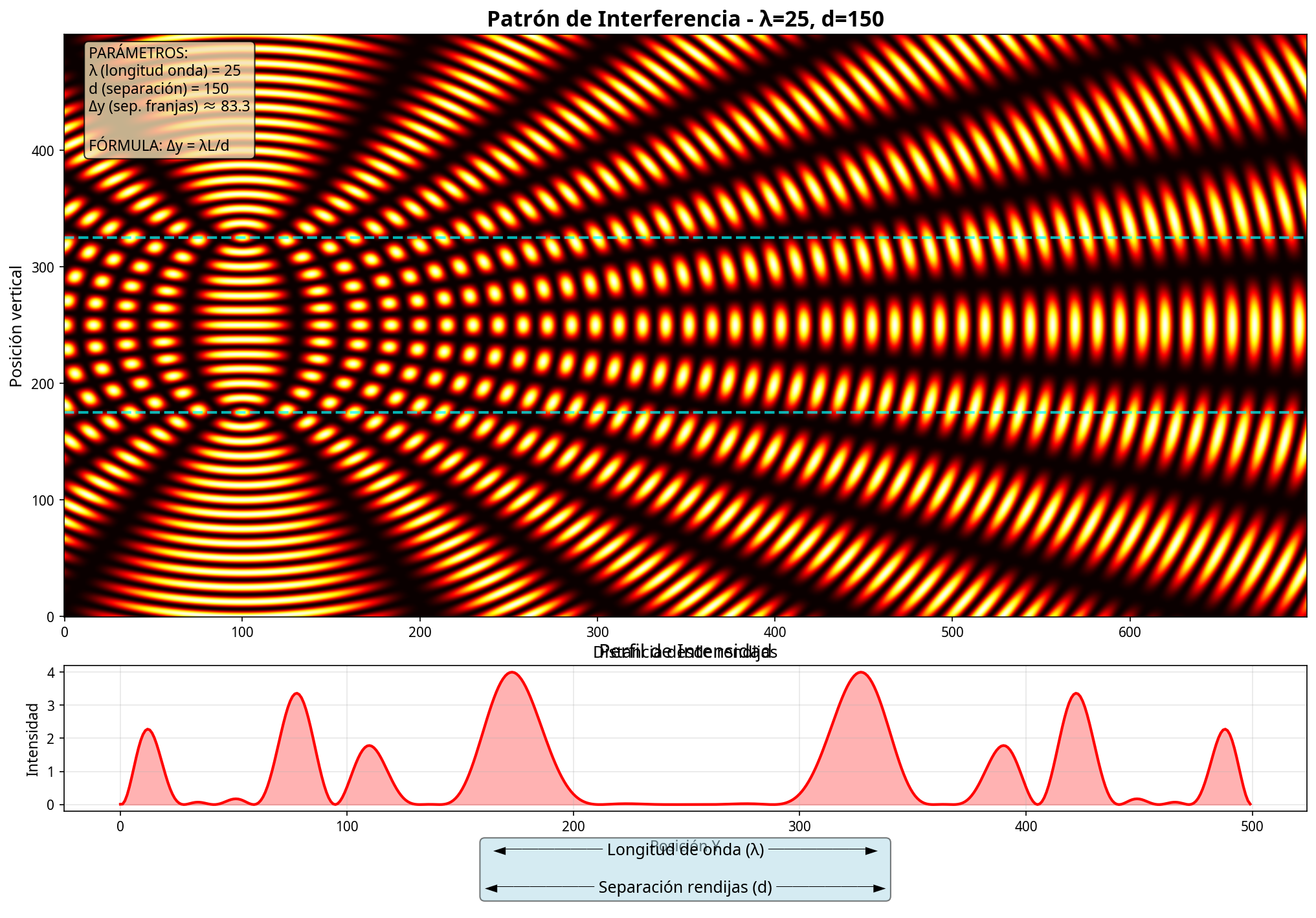
The simulation shows both the 2D interference pattern and a 1D intensity profile, with interactive controls at the bottom for parameter adjustment.
4. Quantum Simulation - The Observer Effect ⭐
This is the most impressive and conceptually profound simulation. It demonstrates the quantum mechanical observer effect: the phenomenon where the act of measurement fundamentally changes the behavior of quantum particles.
Key Features:
- Individual particle detection simulation
- “OBSERVE” button to toggle measurement
- Side-by-side comparison of theoretical and experimental patterns
- Accumulation of particle detections over time
- Clear demonstration of wave function collapse
Visual Result:
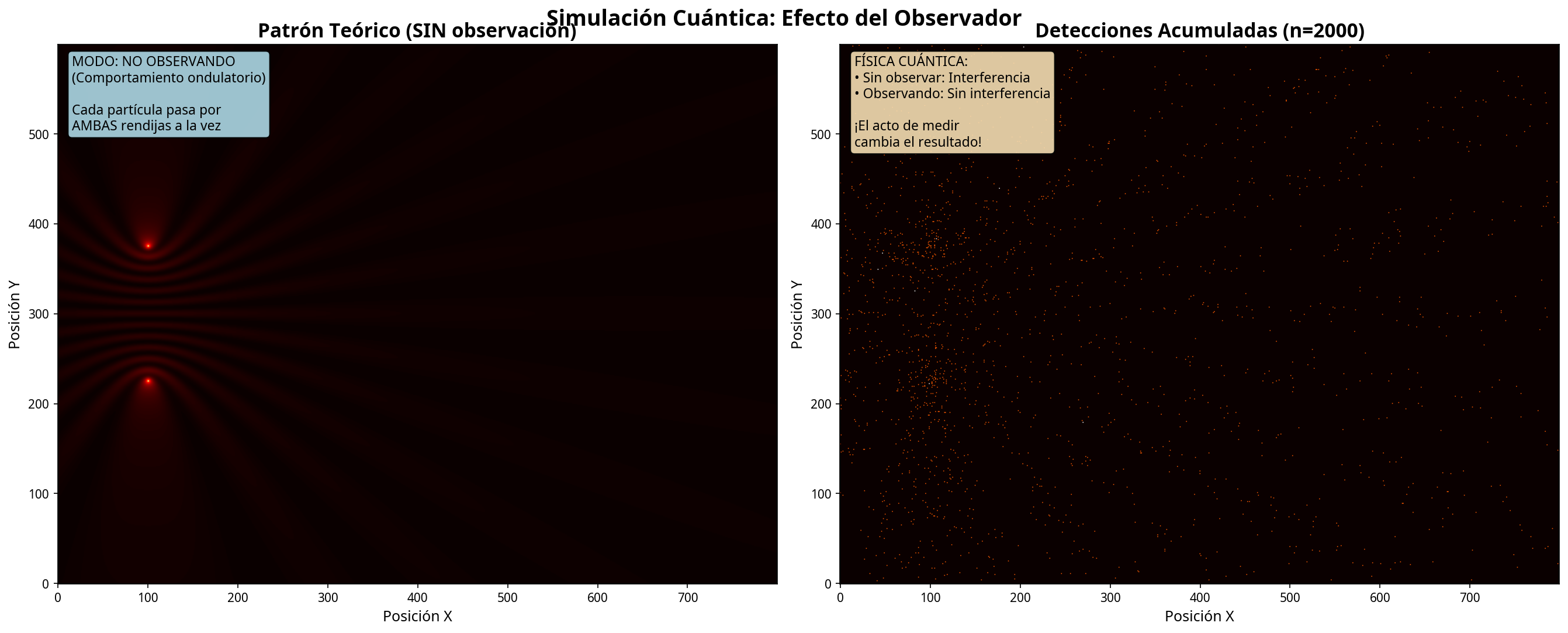
The left panel shows the theoretical probability distribution, while the right panel accumulates individual particle detections. When observation is activated, the interference pattern disappears.
🔍 The Observer Effect - The Heart of Quantum Mechanics
The most striking result of this project is the demonstration of how observation changes quantum behavior:
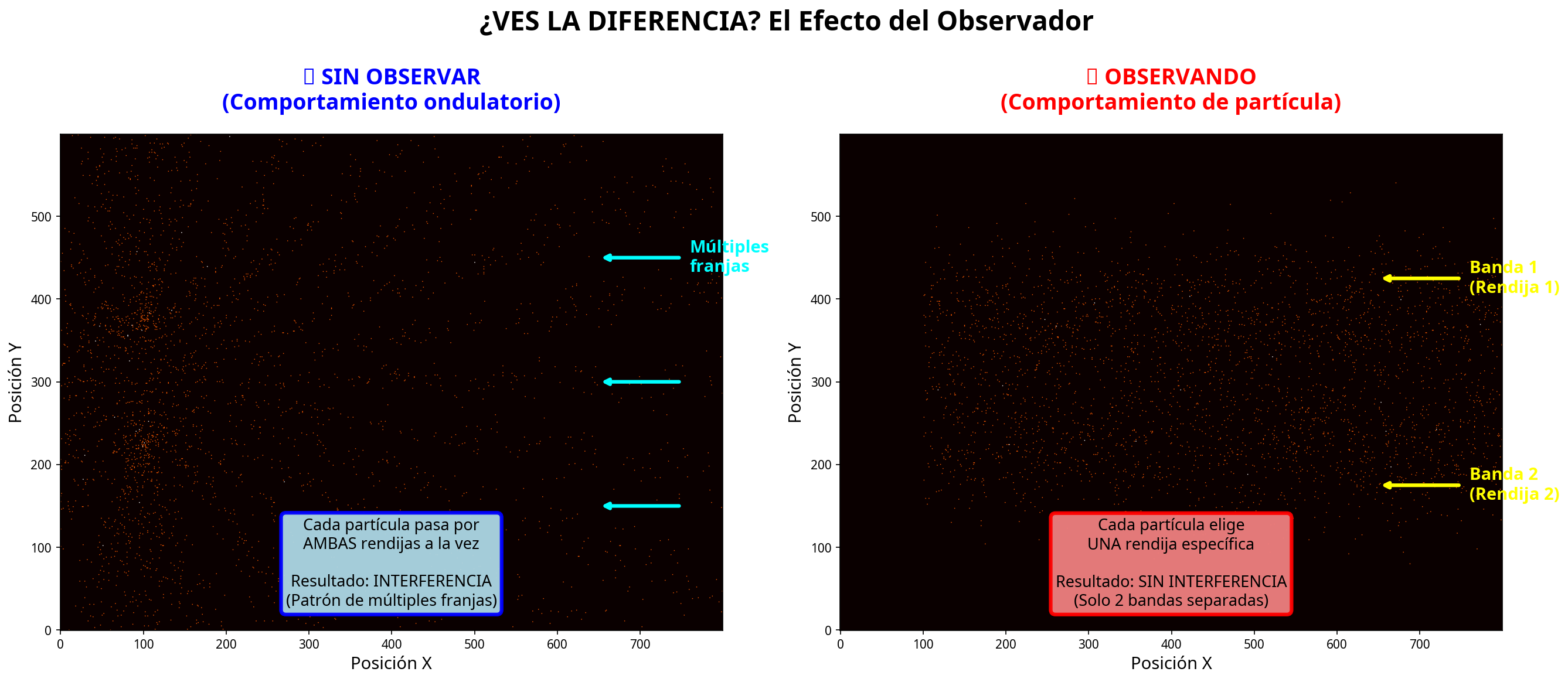
Without Observation (Left - Blue):
- Multiple interference fringes appear
- Each particle behaves as a wave
- The particle passes through both slits simultaneously (quantum superposition)
- Result: Interference pattern with 6-8 visible bands
With Observation (Right - Red):
- Only 2 bands appear
- Each particle behaves as a classical particle
- The particle “chooses” one specific slit
- Result: No interference - just two separate distributions
This is the central mystery of quantum mechanics: the act of observing changes reality itself.
📊 Complete Comparison
All four simulations side by side:
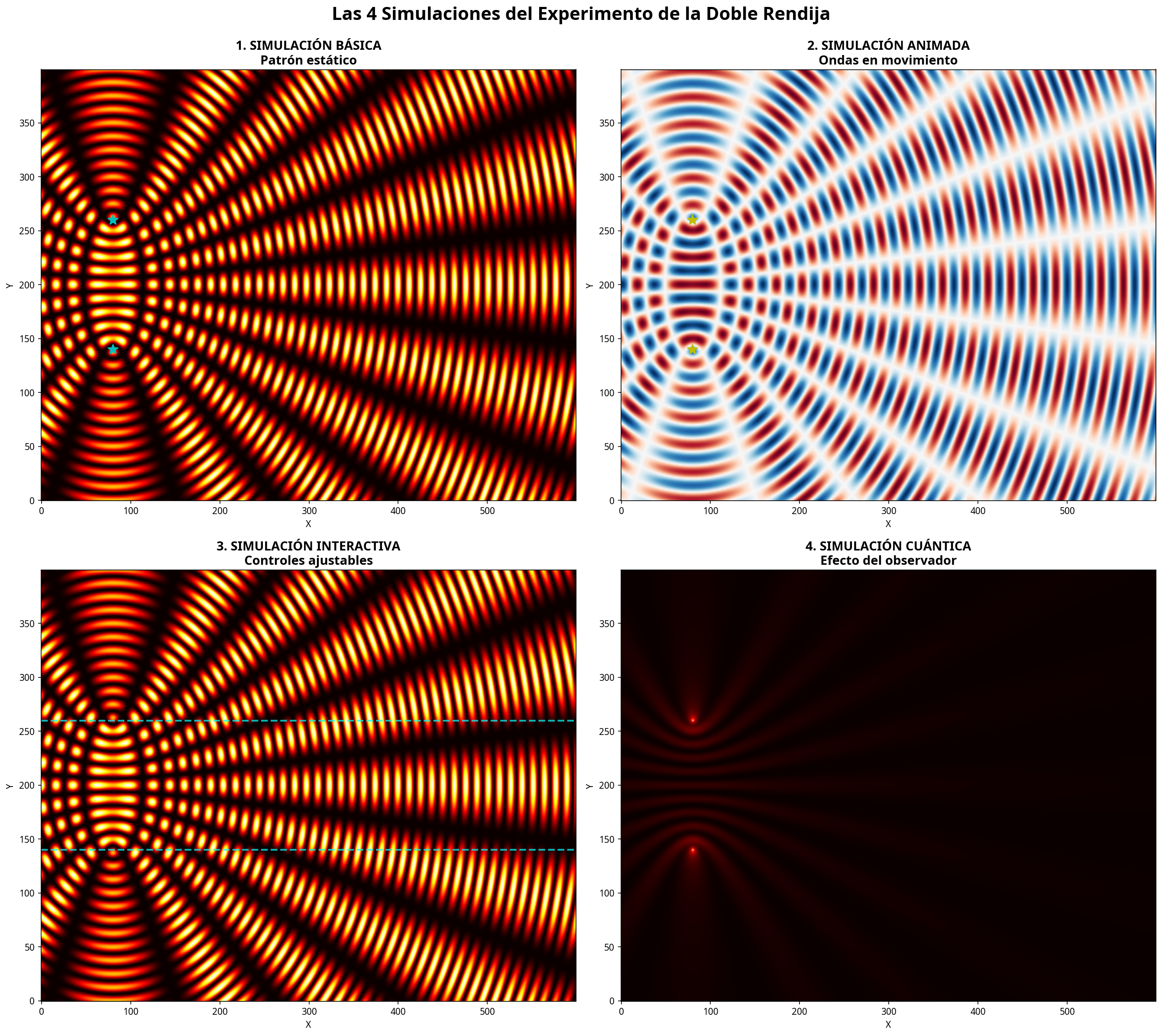
- Top Left: Basic static pattern
- Top Right: Animated wave propagation
- Bottom Left: Interactive with adjustable parameters
- Bottom Right: Quantum simulation with probability distribution
🎓 Physics Explained
Wave Behavior (Classical Physics)
When light passes through two slits, each slit acts as a new source of circular waves (Huygens’ Principle). These waves overlap and interfere:
- Constructive Interference: Wave crests align → bright fringe
- Destructive Interference: Crest meets trough → dark fringe
The spacing between fringes follows Young’s formula:
Δy = λL/d
Where:
- λ = wavelength of light
- L = distance to screen
- d = separation between slits
Quantum Behavior
The quantum version reveals three fundamental principles:
Wave-Particle Duality: Quantum entities exhibit both wave and particle properties depending on how they are observed.
Quantum Superposition: An unobserved particle exists in multiple states simultaneously. In the double-slit experiment, each particle passes through both slits at once.
Wave Function Collapse: When we measure which slit a particle passes through, the wave function collapses. The particle is forced to “choose” one path, and the interference pattern disappears.
As physicist Richard Feynman stated:
“The double-slit experiment contains the only mystery of quantum mechanics.”
💻 Technical Implementation
Platform
- Hardware: Raspberry Pi (any model with Python 3)
- Language: Python 3
- Libraries: NumPy (numerical computation), Matplotlib (visualization)
Installation
Execution
Each simulation can be run independently:
🎤 Recommended Presentation Order
For maximum impact in a physics competition:
- Start with Animated Simulation - Captures attention with visual movement
- Continue with Interactive Simulation - Demonstrates understanding of parameters
- Finish with Quantum Simulation - Delivers the “wow” moment with the observer effect
🏆 Project Significance
This project successfully demonstrates:
✅ Classical wave interference through computational modeling
✅ Quantum superposition and wave function behavior
✅ The observer effect - measurement changing reality
✅ Interactive parameter exploration of physical phenomena
✅ Real-time visualization of abstract quantum concepts
The simulations make abstract quantum mechanics concepts tangible and visually accessible, providing an excellent educational tool for understanding one of physics’ most profound experiments.
📚 Educational Value
This project bridges the gap between theoretical quantum mechanics and practical visualization. It allows students and audiences to:
- See wave interference in action
- Explore how parameters affect patterns
- Understand the quantum measurement problem
- Experience the strangeness of quantum behavior
The double-slit experiment has been called “the most beautiful experiment in physics” by Physics World readers. This simulation brings that beauty to life in an interactive, programmable format.
🎯 Conclusion
The double-slit experiment simulation project successfully demonstrates the fundamental principles of quantum mechanics through four complementary visualizations. From the basic interference pattern to the profound observer effect, each simulation reveals a different facet of wave-particle duality.
The project proves that complex quantum phenomena can be effectively simulated and visualized using accessible technology like the Raspberry Pi, making cutting-edge physics education available to everyone.
Key Takeaway: Quantum mechanics shows us that nature behaves fundamentally differently at the microscopic scale. The act of observation is not passive - it actively participates in creating the reality we measure. This project makes that profound truth visible and interactive.
Project Created By: B.E. Alejandro
Technology: Python 3, NumPy, Matplotlib
Platform: Raspberry Pi
Purpose: Physics Competition / Educational Demonstration
Date: October 2025